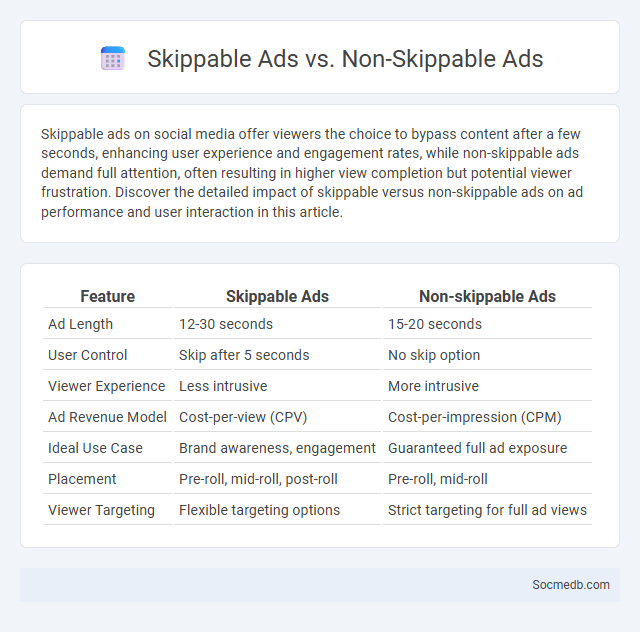
Photo illustration: Skippable Ads vs Non-skippable Ads
Skippable ads on social media offer viewers the choice to bypass content after a few seconds, enhancing user experience and engagement rates, while non-skippable ads demand full attention, often resulting in higher view completion but potential viewer frustration. Discover the detailed impact of skippable versus non-skippable ads on ad performance and user interaction in this article.
Table of Comparison
| Feature | Skippable Ads | Non-skippable Ads |
|---|---|---|
| Ad Length | 12-30 seconds | 15-20 seconds |
| User Control | Skip after 5 seconds | No skip option |
| Viewer Experience | Less intrusive | More intrusive |
| Ad Revenue Model | Cost-per-view (CPV) | Cost-per-impression (CPM) |
| Ideal Use Case | Brand awareness, engagement | Guaranteed full ad exposure |
| Placement | Pre-roll, mid-roll, post-roll | Pre-roll, mid-roll |
| Viewer Targeting | Flexible targeting options | Strict targeting for full ad views |
Introduction to Skippable Ads and Non-skippable Ads
Skippable ads allow your audience to bypass the commercial after a few seconds, enhancing user experience by offering more control over content consumption. Non-skippable ads require viewers to watch the entire advertisement, ensuring complete message delivery and higher brand recall. Understanding these ad formats helps you optimize your social media marketing strategy for better engagement and conversion rates.
Defining Skippable Ads: Features and User Experience
Skippable ads are digital advertisements that allow viewers to bypass the ad after a few seconds, enhancing user control and viewer engagement. These ads typically appear on platforms like YouTube and Facebook, featuring a countdown timer and a clickable skip button after 5 seconds. By using skippable ads, your content promotes a balanced user experience, reducing frustration while maintaining brand visibility and campaign effectiveness.
Non-skippable Ads: Characteristics and Viewer Impact
Non-skippable ads on social media platforms typically range from 6 to 15 seconds, ensuring complete viewer exposure and higher brand recall compared to skippable formats. These ads leverage forced attention, increasing the likelihood of message retention but can also lead to viewer frustration or ad fatigue if overused. Understanding your audience's tolerance for such ads helps optimize campaign effectiveness while balancing engagement and user experience.
Ad Revenue Models: Understanding the Basics
Social media platforms generate significant ad revenue through models such as cost-per-click (CPC), cost-per-impression (CPM), and cost-per-action (CPA), each targeting different advertiser goals. These models leverage user data and engagement metrics to optimize ad delivery and maximize return on investment. Understanding the nuances of these ad revenue models is crucial for brands seeking effective social media marketing strategies.
How Skippable Ads Influence Ad Revenue
Skippable ads on social media platforms significantly impact ad revenue by balancing viewer engagement and advertiser satisfaction. These ads generate revenue only when viewers watch beyond the skip threshold, encouraging advertisers to create more compelling content to reduce skip rates. Platforms like YouTube and Facebook optimize ad delivery algorithms to maximize the view-through rate, directly influencing overall ad revenue and advertiser return on investment (ROI).
Revenue Implications of Non-skippable Ads
Non-skippable ads significantly boost social media platform revenues by ensuring full ad exposure, leading to higher advertiser satisfaction and increased demand for premium ad placements. These ads command higher CPM (cost per thousand impressions) rates compared to skippable formats due to guaranteed viewer engagement, contributing to substantial revenue growth. However, excessive use may negatively impact user experience, potentially reducing long-term platform retention and overall revenue.
Comparative Analysis: Skippable vs Non-skippable Ad Performance
Skippable ads on social media yield higher user engagement rates, with a 30% longer average view time compared to non-skippable ads, which often result in higher initial brand recall but increased viewer frustration. Conversion rates for non-skippable ads typically range between 4-6%, whereas skippable ads demonstrate a more variable performance hovering around 3-5%, influenced by ad length and targeting precision. Cost-per-click (CPC) tends to be 15-20% lower for skippable ads, making them more cost-effective for campaigns prioritizing engagement and viewer choice.
User Engagement and Retention: Effects of Ad Types
User engagement and retention on social media platforms vary significantly based on the types of ads presented. Interactive ads, such as polls or quizzes, boost engagement rates by 30% compared to static image ads, keeping your audience actively involved. Video ads with personalized content increase retention time by up to 50%, making your advertising strategy more effective in sustaining user interest.
Best Practices for Maximizing Ad Revenue
Maximizing ad revenue on social media requires precise audience targeting using demographic and behavioral data to deliver relevant content that boosts engagement rates. Employing A/B testing for ad creatives and placements optimizes click-through and conversion rates, enhancing overall campaign performance. Consistently analyzing key performance indicators (KPIs) such as cost per click (CPC), return on ad spend (ROAS), and engagement metrics helps refine strategies for sustainable revenue growth.
Future Trends in Digital Advertising and Ad Monetization
Emerging social media platforms prioritize AI-driven personalization and augmented reality to enhance user engagement and ad relevance, revolutionizing digital advertising strategies. Programmatic advertising coupled with blockchain technology ensures transparent, fraud-resistant ad transactions, increasing publisher revenue and advertiser trust. Interactive and shoppable ads integrated within social feeds will drive higher conversion rates, making ad monetization more seamless and effective for brands and creators.
 socmedb.com
socmedb.com